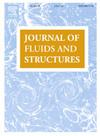潜艇仿生尾缘齿面水动力降噪性能及机理研究
IF 3.4
2区 工程技术
Q1 ENGINEERING, MECHANICAL
引用次数: 0
摘要
随着潜艇航速的增加,潜艇船帆产生的水动力噪声变得更加明显。受猫头鹰翼后缘锯齿形降噪能力的启发,本文提出了应用于潜艇船帆后缘的锯齿形降噪结构。采用大涡模拟和Ffowcs williams - hawkins方程研究了锯齿对风帆处流动和噪声特性的影响。四极噪声源通过结合配方Q1A的可渗透表面捕获。揭示了后缘锯齿降低流动噪声的物理机制。实验数据验证了水动力和声学计算方法的准确性。研究表明,锯齿形对流动噪声具有双重影响,即偶极噪声和四极噪声的结合。总噪声降低高达4.32 dB。涡旋对偶极子噪声的影响是多种物理机制共同作用的结果。首先,锯齿形诱导了尾缘的流动分离,阻断了锯齿峰的水辐合,从而减小了边界层内的湍流波动;其次,它对尾缘垂直压力波动产生退相干效应,导致偶极噪声源的破坏性干涉。这些锯齿延伸了连续的气流涡旋,延迟了它向发夹涡旋的演变,并延迟了它随后破碎成小尺度涡旋的时间。这种空间涡旋结构的畸变增强了Lamb矢量| _ |和Lighthill应力的大小,从而增强了四极噪声源的能量。在潜艇上采用船帆后缘锯齿形来实现流态降噪,但潜艇的船体降低了其降噪性能。其原因是船体边界层湍流干涉改变了尾缘锯齿处的来流条件,增加了锯齿谷处的非定常压力波动,从而放大了偶极噪声源的强度。本文章由计算机程序翻译,如有差异,请以英文原文为准。
Performance and mechanism of the hydrodynamic noise reduction for biomimetic trailing-edge serrations of a submarine
As submarine speed increases, the hydrodynamic noise generated by the sail of a submarine becomes more pronounced. Inspired by the noise reduction capabilities demonstrated by the serration on the owl’s wing trailing edge, this paper proposes the serration noise reduction structure applied to the sail trailing edge of the submarine. The large eddy simulation and the Ffowcs Williams–Hawkings equation are employed to examine the impact of serration on flow and noise characteristics at the sail. The quadrupole noise source is captured by the permeable surface combined with the formulation Q1A. The physical mechanisms underlying trailing edge serration, which reduce flow noise, are revealed. The accuracy of the hydrodynamic and acoustic calculation methods is verified by experimental data. This study demonstrates that the serration exerts the double effect on the flow noise, which is a combination of dipole and quadrupole noise. Total noise is reduced by up to 4.32 dB. The impact of serration on dipole noise is the combined behavior of multiple physical mechanisms. First, the serration induces flow separation at the trailing edge and block water convergence at the serration peak, thereby diminishing turbulent fluctuations within the boundary layer; Secondly, it causes the decoherence effect on the vertical pressure fluctuations at the trailing edge, resulting in destructive interference in the dipole noise source. The serrations extend the continuous Stream vortex, delaying its evolution into the Hairpin vortex and subsequent fragmentation into small-scale vortex. This distortion of the spatial vortex structure intensifies the magnitude of the Lamb vector and Lighthill stress, thereby enhancing the energy of quadrupole noise source. Flow noise reduction is achieved by applying sail trailing edge serration in a submarine, but the submarine hull diminishes its noise reduction performance. The reason involves turbulent interference in the boundary layer of the hull altering the incoming flow conditions at the trailing edge serration, which increases the unsteady pressure fluctuations at the serration valley, thereby amplifying the intensity of the dipole noise source.
求助全文
通过发布文献求助,成功后即可免费获取论文全文。
去求助
来源期刊

Journal of Fluids and Structures
工程技术-工程:机械
CiteScore
6.90
自引率
8.30%
发文量
173
审稿时长
65 days
期刊介绍:
The Journal of Fluids and Structures serves as a focal point and a forum for the exchange of ideas, for the many kinds of specialists and practitioners concerned with fluid–structure interactions and the dynamics of systems related thereto, in any field. One of its aims is to foster the cross–fertilization of ideas, methods and techniques in the various disciplines involved.
The journal publishes papers that present original and significant contributions on all aspects of the mechanical interactions between fluids and solids, regardless of scale.
 求助内容:
求助内容: 应助结果提醒方式:
应助结果提醒方式:


